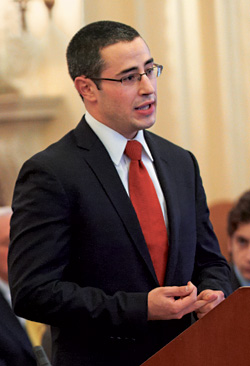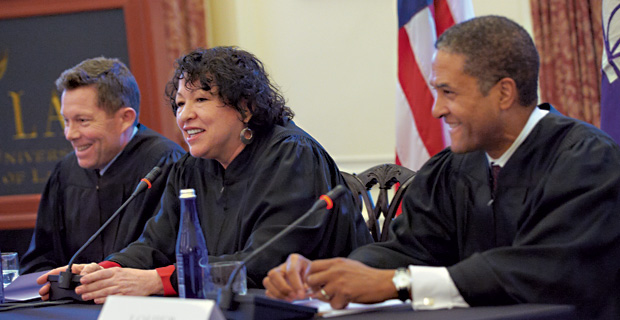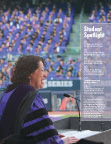Arguments That Inspired a Justice
Printer Friendly VersionA cry of “all rise!” brought the crowd in Greenberg Lounge to its feet on April 9 as final arguments in NYU Law’s 40th annual Orison S. Marden Moot Court Competition got underway. Presiding over the fictional case of Fitts v. United States of America were three real-world members of the bench: U.S. Supreme Court Associate Justice Sonia Sotomayor, Judge Jeffrey Sutton of the U.S. Court of Appeals for the Sixth Circuit, and Judge Raymond Lohier Jr. ’91 of the U.S. Court of Appeals for the Second Circuit.
The case, prepared by Moot Court Board members Jerilyn Laskie ’13 and Nicole Geoglis ’13, centered on the child pornography conviction of one Ezra Fitts and presented two issues for the moot Supreme Court to review. Zachary Briers ’12 and David Hodges ’12 squared off on the first, involving the sufficiency of probable cause for the search that led to Fitts’s arrest. Thomas Bennett ’12 and Paul Brachman ’13 debated the second: whether a court could properly order Fitts, who was convicted solely of possession of child pornography, to pay restitution to the victim depicted in those materials.
As is common in the actual Supreme Court, each of those arguing received tough questions from the justices. At one point, Sotomayor asked Briers whether he rejected the Eighth Circuit’s position on an issue relating to search warrants, and Sutton then pressed Briers on the matter. “Do you concede the Eighth Circuit’s wrong?” Sutton asked. “No skin off your nose,” Sutton joked after Briers offered a hesitant yes. “I had to think about who is on which circuit here,” Briers responded, causing the room to erupt in laughter.
Sotomayor posed a thorny issue to Brachman on restitution: “Why should this one defendant who happens to get caught pay the price for the person who made the film and every other person who the victim is suffering about? Why should this one individual bear the brunt of the entire cost?”
 “Because it’s so difficult to determine with exactitude how each possessor causes harm to victims like John Doe,” said Brachman, “it makes a great deal of sense both as a matter of law and as a matter of policy to impose the burden for remedying the harm on the individuals who caused the harm rather than on the victims.” Later, he added, “The petitioner’s argument boils down to this: It’s okay to rub salt in a wound because I didn’t inflict the first cut, and because so many people have rubbed salt in the wound we can’t tell which grain of salt caused the injury. That interpretation is perverse and contrary to the purposes for which the statute was enacted.”
“Because it’s so difficult to determine with exactitude how each possessor causes harm to victims like John Doe,” said Brachman, “it makes a great deal of sense both as a matter of law and as a matter of policy to impose the burden for remedying the harm on the individuals who caused the harm rather than on the victims.” Later, he added, “The petitioner’s argument boils down to this: It’s okay to rub salt in a wound because I didn’t inflict the first cut, and because so many people have rubbed salt in the wound we can’t tell which grain of salt caused the injury. That interpretation is perverse and contrary to the purposes for which the statute was enacted.”
The justices named Brachman (right) as Best Oralist. “We pick one person,” said Sotomayor, “but there really shouldn’t be any losers because each of you has done an extraordinary job.”
Lohier was likewise impressed: “I think it’s fair to say that, based on what I saw this evening, you’d do exceptionally well before the Second Circuit. I think that the most important thing, besides candor—never forget candor in your responses—is to listen to the question and to answer the question. All four of you were able to do that in a very professional way.” Lohier is currently (and Sotomayor was formerly) an adjunct faculty member at NYU Law.
“Why do I bother doing a moot court, adding another case to my docket?” Sotomayor asked as the event drew to a close. “I do it because after I engage in an exercise like this by students, I’m inspired. I’m inspired because I know that those who are following in the job I love so much—lawyering—are being trained so well that you give me hope, both about the profession and about the future of the profession and my job.”
—

